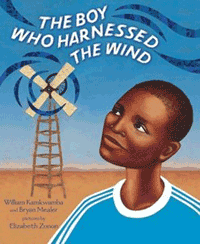The story, which can be read for free online at wegivebooks.org, is based on Kamkwamba's New York Times best-selling memoir by the same name, also co-authored by Mealer.
Blog: HOMESPUN LIGHT (Login to Add to MyJacketFlap)
JacketFlap tags: inspirational, teen, review by Cindy B., The boy who harnessed the wind, William Kambewamba, book review, adult, nonfiction, Add a tag

The Boy Who Harnessed the Wind by William Kambewamba
Book Review by Cindy Bohn of Digging Up Bohns
In the LDS Church, we are encouraged to fast for two consecutive meals on the first Sunday of every month. It's not just 'going hungry' - we are to ask for spiritual help with something, or to bless someone else, and to pray for an increased measure of the Spirit as we fast. Then we take the money we would have spent on those meals and donate it to the Church for the support of the poor in our area. I must admit that I am not great about following this practice. We have always been faithful in the payment of our fast offerings, donating as much as we could, much more than the cost of the food itself, whenever we can. But the going without food part is hard for me.
This weekend I grabbed a library book that will forever change how I look at the fast. It's called "The Boy Who Harnessed the Wind," by William Kambewamba. William grew up in the African nation of Malawi, the son of a farmer. His family would grow maize, or corn, and tobacco every year, milling the food they needed for themselves and using the money they earned to provide for their needs for the year. One year they had planted their maize, as usual, but the rains didn't come. For weeks the crop struggled along, with the seeds barely breaking through the soil. Then the rains came, but all at once. The seeds were washed away in a flood. William's family planted again, but they couldn't afford fertilizer and the crop didn't have enough time to grow before the harvest. The entire nation was affected.
His family got their pitiful harvest of grain milled, one bag at a time, but they had only five bags to last them all year. At first, they hoped that the government would come through with the food they needed. But instead, corrupt officials sold what grain they could and the surplus disappeared. So people starved. When the grain was almost gone, the hungry people took the husks of the corn, the green part I throw away every time I cook corn, and ground that up and ate it. When it began to run out, they mixed the husks with sawdust and ate that. They ate the leaves of the pumpkin vines. They even ate the seed corn, scrubbing off as much insecticide as they could. William's family saved their seed corn, but they were down to a tablespoon of food or so a day. Then it was time to plant. With their bellies aching from hunger, and sometimes too dizzy to stand and temporarily blinded, they found the strength to plant their seeds. And then they prayed. The rains came, and the people had food again.
As I read William's story, and his desperate attempts to gain an education and break this cycle of subsistence farming, I found myself thinking about my cupboard full of food. All those stories of 'children starving in Africa' and how I needed to clean my plate ran through my head. And yet, what would William have done with my breakfast cereal, my mashed potatoes and meat loaf, my tuna casserole? They wouldn't have even known what it was, much less how to cook it. Their special Christmas treat was rice and meat.
Last night I prepared for my fast today with a completely different attitude. It wasn't that by fasting I could somehow bless those who are hungry in tiny nations across the world. It wasn't even that I
Blog: Write About Now (Login to Add to MyJacketFlap)
JacketFlap tags: The Boy Who Harnessed the Wind, Add a tag
Everyone told him he was crazy.
But William Kamkwamba had a dream. He believed he could make a difference for his family and his village.
At 14 he dropped out of school because his parents couldn't afford the $80/year fee. But he still loved to learn. He borrowed books from the local library and just from the pictures (he couldn't read English!) taught himself how to build a windmill. Using scraps from the village - a tractor fan, a discarded bicycle wheel - he built a windmill that powered a radio and a light bulb.
He now has four windmills that provide electricity for families and pump water to irrigate their fields. His memoir is being published this fall.
Watch this and be inspired.




Wonderfully written review (and thanks for teaching me some things I didn't know about LDS, too)
I have to get this one now :-)